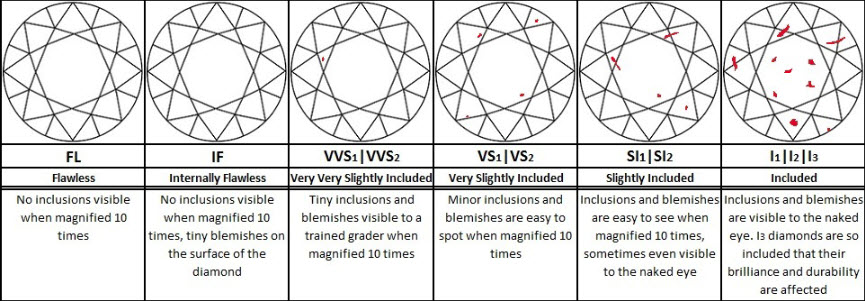Diamond Clarity and the 4 C’s
Clarity refers to the internal state of a diamond as seen under 10x magnifications. The cleaner or purer the diamond is on the inside, the greater the value of the stone. Most diamonds have slight imperfections, or flaws, within them. Inclusions or flaws are caused as a result of mineral deposits, irregular crystals, breaks, or cracks.
Get to Know Your Diamond Clarity Scale
A clarity scale will determine the number and type of inclusions. The Gemological Institute of America (GIA) and the American Gem Society (AGS) both have created the following scale to grade the clarity of diamonds.

What Clarity is Right for You?
While clarity is very important to consider when searching for a diamond, it important to analyze all 4C’s – Carat, Clarity, Color, and Cut. Some people care more about size than cut, some more clarity than color. Most importantly, be as knowledgeable as you can before purchasing your very special diamond! Our opinion is the Cut of the stone is the most important.
Grading Non-Certified Diamonds
What does an inclusion in a diamond look like?
- Crystals – There are 24 different minerals that have been identified as crystal inclusions in diamonds. Small crystals that appear to be small specks, even under ten-point magnification, are called pinpoints. Normally, depending on the size, crystals lower the clarity grade of your diamond, but at times they can turn the diamond into a collector’s item if the crystal is rare or attractive.
- Feathers – These are small fissures in the diamond. Most feathers are difficult to see even by the untrained eye even when viewed under 10x magnification. Feathers are one of the most common inclusions found in diamonds.
- Clouds – Clouds are usually created by a small cluster of tiny crystals that cannot be seen under 10-point magnification. When a diamond is graded with high clarity, then clouds will be difficult to discern.
- Grain Lines – Grain lines are caused by slight, irregular crystallization and may look like fine lines on the surface or in the diamond. At times, they are called twinning lines.
- Cavities – Inclusions are called cavities when a surface-reaching crystal has come out during polishing.
- Knots – Knots are diamond crystals that have become included and left exposed on the surface of the diamond by polishing.
- Laser Drill Holes – Laser drill holes are tiny holes that are drilled into the diamond with a laser beam. Laser drilling improves the appearance of the diamond by changing a black crystal into a white inclusion.
- Naturals – Naturals are part of the original surface of the stone that has been left unpolished. Naturals usually have no effect on the clarity grade if they remain in the girdle.
The fewer the inclusions or imperfection – the more valuable the stone. A diamond’s measure of clarity is determined by the size, number, type, and placement of the imperfections.
Location of the Imperfection
When a diamond is certified, the stone’s certificate will include a graph that will highlight its flaws and inclusions. Most lab certificates have plots of inclusions (marked in red for internal and green for external features); they are useful for identification. Often only the main “grade makers” are plotted, and additional inclusions are listed in the comments area of the report.
